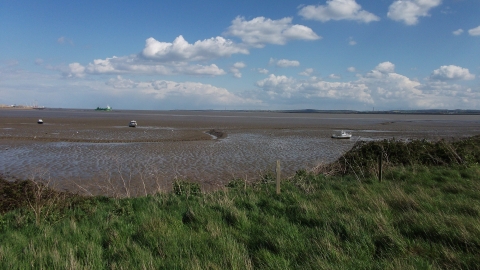 |
| source - Essex Wildlife Trust |
The history of this nature reserve is a fascinating and convoluted one. Like so much of this area bordering east London and the river it started life as a gravel quarry (although its ancient history can be traced all the way back to a Stone Age settlement) before becoming a landfill site for 50 years. In 2012 it was finally closed as a tip and work began to return it to nature under the auspices of The Cory Environmental Trust, DP World Port and the Essex Wildlife Trust. The 100ft-high piles of waste - half a century's worth of household rubbish from six London boroughs - was first covered over by a layer of thick clay (fortunately also found in abundance in this part of the world) before fresh soil and suitable plants were added. A varied landscape of grassland, woodland, ponds and reedbeds has been created, with the seawall at the east end of the site being deliberately breached to allow the area to revert to marshland.
.jpg?h=5793e458&itok=VI5hvy3L) |
| source - Essex Wildlife Trust |
An ingenuously-designed visitor centre was also built in 2013 - wood-clad and circular in shape it has wonderful views of the entire reserve as well as the estuary, not least from the 360º viewing platform on its roof, and sits on hydraulic jacks that allow for the movement of the rubbish beneath as it continues to settle.
I can certainly attest to the excellence of the visitor centre, which as well as the aforementioned views contains a wealth of informative displays plus the obligatory EWT shop and a decent cafe. I first visited the place with my parents shortly after it first opened, which was how I knew of its existence and thought of it as a worthwhile place to take my then-new lady friend.
 |
| Looking east out into the estuary source - Essex Wildlife Trust |
As I recall it was a mild if slightly blustery day - not unusual on that exposed part of the estuary - as we parked up and commenced walking around one of the myriad pathways that reach out in all directions from the visitor centre. The entire reserve is currently about 120 acres in size (although the aim is for that to increase to a massive 845 acres - twice the size of Regent's Park) and forms part of the Thames Estuary Path which runs along the coast practically uninterrupted for 27 miles from Tilbury all the way to Leigh-on-sea. Needless to say we contented ourselves with staying to within a mile or so of the centre but there was still plenty to see.
 |
| Looking towards Stanford-le-Hope/ Horndon-on-the-Hill on the Essex coast |
 |
| Sailing boats over on the Kent (Cliffe) side of the river took advantage of the breeze |
Unfortunately I am never going to win the Wildlife Photographer of The Year and as we were busy walking around, taking in the sights and enjoying each other's company I had little time or opportunity to take much in the way of photos. The two above and three below therefore constitute the best of a poor bunch, but I hope they give a little idea of the splendid variety of wildlife and the fantastic effort that has gone in to turning a once barren and industrial wasteland into a beautiful and thriving nature reserve.
 |
| Thistles amidst the grassland |
 |
| A close-up of a cardinal beetle taking a break atop a thistle |
 |
| More thistles and some unidentified purple flowers (I'm afraid I'm no horticulturist either so if any green-fingered readers want to enlighten me I'll happily update this caption!) |
After our circuit of some of the shorter routes we repaired to the visitor centre for a light snack in the cafe (quite passable) and an enjoyable wander around inside and out (access to the rooftop viewing platform is via a circular ramp that runs around the outside of the building, which allows for good views as you make your way to the top). One other thing the visitor centre had, which appealed to us more as bibliophiles than naturalists it has to be said, was a small selection of second-hand books tucked away in the corner of the cafe. While unsurprisingly most are of an environmental or horticultural bent there are often quite a number of other genres both fiction and non-fiction so to finish off this post here are two acquisitions from that stall (although neither of them came from this particular visit).
The Friendless Sky was actually my most recent find from a return visit and is exactly what it says on the cover; it joins my already-burgeoning collection of World War One literature but was a jolly good read and complements my library well. Likewise Captain Starlight by Percy F. Westerman, a contemporary of Biggles author W. E. Johns and while maybe not quite as well-rounded still a ripping adventure yarn. This came out of my very first visit with my parents and served as an introduction to Westerman's work, further examples of which I have since added to my collection.
I have no doubt that we will return to Thurrock Thameside Nature Reserve again (and not just for the books!) and can wholly recommend this - still sadly somewhat hidden - gem should you ever be in the area.


No comments:
Post a Comment
Don't just sit there, type something! I enjoy reading all friendly and positive comments.